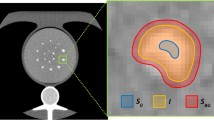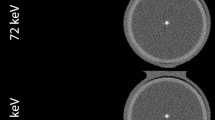Abstract
Geometric and densitometric methods for quantitative coronary arteriography have generally been compared by use of phantoms simulating arteries with circular lumina (‘Hole phantoms’). We have used more adequate phantoms obtained by casting disease-free and atheromatous human coronary arteries. The phantoms, filled with contrast medium, were imaged digitally (1024 × 1024 × 10 matrix) under experimental conditions simulating routine coronary angiography. The angiographic ‘diameters’ and the densitometric cross-sectional areas of 59 marked lumina were determined in single plane and orthogonal biplane raw images. Geometric calibration was performed by help of a 7F coronary catheter. For the densitometric calibration, we used a ‘hole phantom’ attached to the image intensifier. The obtained luminal areas were compared to their true values determined previously by planimetry. The mean absolute error of single plane cross-sections obtained geometrically was 1.53 mm2. Biplane imaging reduced it by a factor 2.4 to 0.64 mm2. The corresponding mean absolute errors for densitometry were 0.56 mm2 and 0.51mm2. Single plane ‘diameter’ measurements appear thus of very limited value for hemodynamic conclusions. In contrast, biplane geometric quantification was not markedly inferior to single plane and biplane densitometry.
Similar content being viewed by others
References
Reiber JHC. Morphologic and densitometric quantitation of coronary stenoses; an overview of existing quantitation techniques. In: Reiber JHC, Serruys PW, editors. New developments in quantitative coronary arteriography. Dordrecht (NL): Kluwer Academic Publishers, 1988: 34–88.
Reiber JHC. An overview of coronary quantitation techniques as of 1989. In: Reiber JHC, Serruys PW, editors. Quantitative coronary arteriography. Dordrecht (NL): Kluwer Academic Publishers, 1991: 55–132.
Mancini GBJ, Simson SB, McGillem MJ, LeFree MT, Friedman HZ, Vogel RA. Automated quantitative coronary arteriography: Morphologic and physiologic validationin vivo of a rapid digital angiographic method. Circulation 1987; 75: 452–60 (With erratum in Circulation 1987; 75: 1199).
LeFree MT, Simon SB, Mancini GBJ, Bates ER, Vogel RA. A omparison of 35 mm cine film and digital radiographic image recording: Implications for quantitative coronary arteriography film vs digital coronary quantification. Invest Radiol 1988; 23: 176–83.
Doriot PA, Rasoamanambelo L, Honegger HP, Mérier G, Bopp P, Rutishauser W. Measurement of the degree of coronary stenosis by digital densitometry. In: Computers in Cardiology 1981. IEEE Computer Society, 1982: 329–32.
Nichols AB, Gabrieli CFO, Fenoglio JJ, Esser PD. Quantification of relative coronary arterial stenosis by cinevideodensitometric analysis of coronary arteriograms. Circulation 1984; 69: 512–22.
Thomas AC, Davies MJ, Dilly S, Dilly N, Franc F. Potential errors in the estimation of coronary arterial stenosis from clinical arteriography with reference to the shape of the coronary arterial lumen. Br Heart J 1986; 55: 129–39.
Kirkeeide RL, Fung P, Smalling RW, Gould KL. Automated evaluation of vessel diameter from arteriograms. In: Computers in Cardiology 1982. IEEE Computer Society, 1982; 215–8.
Barth K, Eicker B, Bittner U, Marhoff P. The improvement of vessel quantification with image processing equipment for high resolution digital angiography. In: Lemke HU, Rhodes ML, Jaffe CC, Felix R, editors. Computer Assisted Radiology, International Symposium CAR 89. Berlin Heidelberg: Springer Verlag, 1989: 220–5.
Vlodaver Z, Edwards JE. Pathology of coronary atherosclerosis. Prog Cardiovasc Dis 1971; 14: 256–74.
Freudenberg H, Lichtlen PR. The normal wall segment in coronary stenosis — A post mortem study. Z Kardiol 1981; 70: 863–9.
Baroldi G. Diseases of the coronary arteries In: Silver MD, editor. Cardiovascular Pathology. New York: Churchill Livingstone, 1983; 341–2.
Waller BF. Coronary luminal shape and the arc of diseasefree wall: morphologic observations and clinical relevance. JACC 1985; 6(5): 1100–1.
Wollschläger H, Zeiher AM, Lee P, Solzbach U, Bonze LT, Just H. Optimal biplane imaging of coronary segments with computed triple orthogonal projections. In: Reiber JHC, Serruys PW, editors. New developments in quantitative coronary arteriography. Dordrecht (NL): Kluwer Academic Publishers, 1988: 13–21.
Reiber JHC, Serruys PW, Kooijman CJ, Wijns W, Slager CJ, Gerbrands JJ, et al. Assessment of short-, medium- and long-term variations in arterial dimensions from computerassisted quantitation of coronary cineangiograms. Circulation 1985; 71: 280–8.
Reiber JHC, Eldick-Helleman P van, Kooijman CJ, Tijssen JGP, Serruys PW. How critical is frame selection in quantitative coronary angiographic studies? Europ Heart J 1989;10 Suppl F: 54–9.
Reiber JHC, Eldick-Helleman P van, Visser-Akkerman N, Kooijman CJ, Serruys PW. Variabilities in measurement of coronary arterial dimensions resulting from variations in cineframe selection. Cathet Cardiovasc Diagn 1988; 14: 221–8.
Doriot PA, Guggenheim N, Dorsaz PA, Rutishauser W. Morphometric versus densitometric assessment of coronary vasomotor tone — An overview. Europ Heart J 1989; 10 Suppl. F: 49–53.
Sanders WJ, Alderman EL, Harrison DC. Coronary artery quantitation using digital image processing. In: Computers in Cardiology 1979. IEEE Computer Society, 1979: 15–20.
Siebes M, Selzer RH. How accurate is the catheter as a reference for arterial dimensions in quantitative coronary angiography? In: Computers in Cardiology 1985. IEEE Comput Society, 1985: 9–14.
Reiber JHC, Kooijman CJ, Boer A den, Serruys PW. Assessment of dimensions and image quality of coronary contrast catheters from cineangiograms. Cathet Cardiovasc Diagn 1985; 11: 521–31.
Nichols AB, Berke AD, Han J, Reison DS, Watson RM, Powers ER. Cinevideodensitometric analysis of the effect of coronary angioplasty on coronary stenotic dimensions. Am Heart J 1988; 115(4): 722–32.
Wiesel J, Grunwald AM, Tobiasz C, Robin B, Bodenheimer MM. Quantitation of absolute area of a coronary arterial stenosis: Experimental validation with a preparationin vivo. Circulation 1986; 74: 1099–106.
Balkin J, Rosenmann D, Ilan M, Zion MM. Reproducibility of measurements of coronary narrowing by videodensitometry: Unreliability of single view measurements. J Cardiac Imag 1990; 5(2–3): 119–24.
Author information
Authors and Affiliations
Rights and permissions
About this article
Cite this article
Doriot, P.A., Suilen, C., Guggenheim, N. et al. Morphometry versus densitometry — a comparison by use of casts of human coronary arteries. Int J Cardiac Imag 8, 121–130 (1992). https://doi.org/10.1007/BF01137533
Accepted:
Issue Date:
DOI: https://doi.org/10.1007/BF01137533




